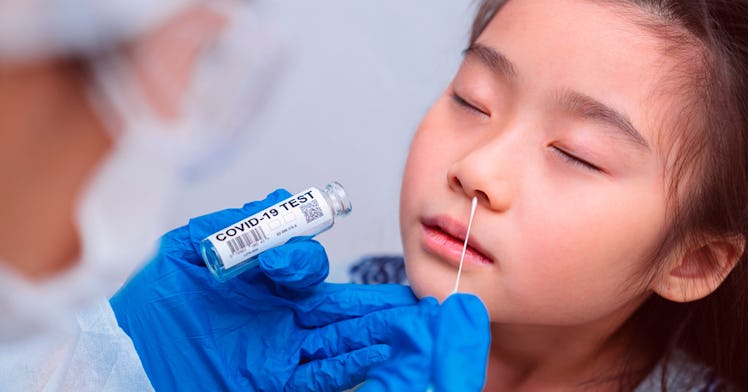How to Get Non-Invasive COVID Testing for Kids
Brain-tickling nose swabs make testing kids a nightmare. Here are your alternatives.

For the 15th week in a row, kids’ COVID cases have topped 100,000. Overall, cases continue to rise in many parts of the country, and the holidays might only make that worse. This means children, particularly those who are unvaccinated, are going to have more and more COVID scares. They’re going to need to get tested more often for the foreseeable future of the COVID-19 pandemic, especially with other viruses causing similar symptoms during flu season. And COVID testing for kids is no easy feat. Considering how invasive the COVID test is, your kid is sure to put up a fight — or shed some tears. Most COVID testing for kids and adults alike is done with nasopharyngeal swabs that go deep into the nose and are incredibly uncomfortable. Some people describe the tests as tickling or even stabbing their brain. But there are non-invasive COVID tests that are faster, cheaper, and a hell of a lot more bearable for kids.
Non-Invasive Saliva COVID Testing for Kids
In the early days of the pandemic, some experts were skeptical of looking for coronavirus in saliva samples. But the saliva testing method is becoming more and more popular. Spitting into a test tube is more pleasant than getting swabbed in the back of the nose. And recent studies suggest it may be as accurate.
When getting your kids a spit test for COVID-19, make sure they don’t eat or drink for at least a half hour before the test. They will need to spit and drool between one and five milliliters of saliva into a small test tube, which can take up to 12 minutes. The sample is then shipped off to a lab and analyzed for the coronavirus. The amount of time it takes before you get a result depends on the testing location and company you use. Your child will need to be old enough to follow these directions, about 4 years old, to use a saliva test.
The problem with saliva tests is that they can be difficult to find. Not all testing facilities offer spit tests, and it’s easier to get one in some states than others. If you live in Minnesota, for example, saliva tests are free and available to everyone. But if there aren’t options available in your area, you can get one delivered to your home from this list of at-home COVID tests.
Saliva tests are best for use when a child either has COVID symptoms or has a known exposure. When a person has minimal or mild symptoms, saliva tests are just as accurate as deep nose swabs, according to a systematic review and meta-analysis published in JAMA Internal Medicine in January. However, Children’s Hospital of Colorado has found that although saliva COVID tests are accurate for children with symptoms, they are much worse at detecting infection in kids who are asymptomatic. So saliva tests should not be used for screening kids who don’t have symptoms.
Nasal and Throat Swab COVID Testing for Kids
Not all swabs go as far back into the nose as the standard nasopharyngeal swab. Newer COVID testing for kids uses a nasal swab that goes inside the nostrils but not so far that it feels like it’s scraping your brain. These nasal tests are sometimes given in conjunction with oral swabs of the throat, so these types aren’t completely free of discomfort. But there’s much less internet outcry about this kind of test compared to the nasopharyngeal swab.
During the test, a healthcare worker first presses down the tongue while swabbing the throat next to and behind the tonsils. They then sample each nostril using the same swab. Some testing locations may forego the throat swab and use the nasal swab only, though this technique could be less sensitive.
There are also at-home COVID rapid test options. One study from May found that self-collected mid-nasal swabs were nearly as accurate at detecting COVID infection as professionally collected deep nose swab samples. For young children, a parent will have to swab their nose. Rapid tests are in short supply right now, but with an increase in government funding, they should become more available soon.
Like the saliva test, it is likely that the nasal/throat test is less sensitive than the deep nose test. However, one small study did find that mid-nasal tests are more accurate than saliva tests.
Non-invasive COVID tests for kids are less accurate than the “gold standard” nasopharyngeal swab. But they are more comfortable. Whether that tradeoff is worth it is a decision only you can make (with the help of your doctor, of course).
This article was originally published on